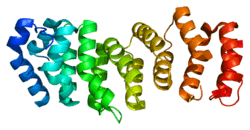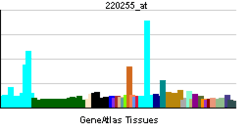FANCE
Not to be confused with
France.
Fanconi anemia group E protein is a protein that in humans is encoded by the FANCE gene.[3][4][5]
Function
The Fanconi anemia complementation group (FANC) currently includes FANCA, FANCB, FANCC, FANCD1 (also called BRCA2), FANCD2, FANCE, FANCF, FANCG, and FANCL. Fanconi anemia is a genetically heterogeneous recessive disorder characterized by cytogenetic instability, hypersensitivity to DNA crosslinking agents, increased chromosomal breakage, and defective DNA repair. The members of the Fanconi anemia complementation group do not share sequence similarity; they are related by their assembly into a common nuclear protein complex. This gene encodes the protein for complementation group E.[5]
Interactions
FANCE has been shown to interact with:
References
- ↑ "Human PubMed Reference:".
- ↑ "Mouse PubMed Reference:".
- ↑ Joenje H, Lo ten Foe JR, Oostra AB, van Berkel CG, Rooimans MA, Schroeder-Kurth T, Wegner RD, Gille JJ, Buchwald M, Arwert F (Oct 1995). "Classification of Fanconi anemia patients by complementation analysis: evidence for a fifth genetic subtype". Blood. 86 (6): 2156–60. PMID 7662964.
- ↑ de Winter JP, Léveillé F, van Berkel CG, Rooimans MA, van Der Weel L, Steltenpool J, Demuth I, Morgan NV, Alon N, Bosnoyan-Collins L, Lightfoot J, Leegwater PA, Waisfisz Q, Komatsu K, Arwert F, Pronk JC, Mathew CG, Digweed M, Buchwald M, Joenje H (Nov 2000). "Isolation of a cDNA representing the Fanconi anemia complementation group E gene". Am J Hum Genet. 67 (5): 1306–8. doi:10.1016/S0002-9297(07)62959-0. PMC 1288571
 . PMID 11001585.
. PMID 11001585. - 1 2 "Entrez Gene: FANCE Fanconi anemia, complementation group E".
- 1 2 3 Taniguchi T, D'Andrea AD (Oct 2002). "The Fanconi anemia protein, FANCE, promotes the nuclear accumulation of FANCC". Blood. 100 (7): 2457–62. doi:10.1182/blood-2002-03-0860. PMID 12239156.
- 1 2 3 Medhurst AL, Huber PA, Waisfisz Q, de Winter JP, Mathew CG (Feb 2001). "Direct interactions of the five known Fanconi anaemia proteins suggest a common functional pathway". Hum. Mol. Genet. 10 (4): 423–9. doi:10.1093/hmg/10.4.423. PMID 11157805.
- 1 2 3 4 5 Pace P, Johnson M, Tan WM, Mosedale G, Sng C, Hoatlin M, de Winter J, Joenje H, Gergely F, Patel KJ (Jul 2002). "FANCE: the link between Fanconi anaemia complex assembly and activity". EMBO J. 21 (13): 3414–23. doi:10.1093/emboj/cdf355. PMC 125396
 . PMID 12093742.
. PMID 12093742. - ↑ Meetei AR, de Winter JP, Medhurst AL, Wallisch M, Waisfisz Q, van de Vrugt HJ, Oostra AB, Yan Z, Ling C, Bishop CE, Hoatlin ME, Joenje H, Wang W (Oct 2003). "A novel ubiquitin ligase is deficient in Fanconi anemia". Nat. Genet. 35 (2): 165–70. doi:10.1038/ng1241. PMID 12973351.
- 1 2 Gordon SM, Buchwald M (Jul 2003). "Fanconi anemia protein complex: mapping protein interactions in the yeast 2- and 3-hybrid systems". Blood. 102 (1): 136–41. doi:10.1182/blood-2002-11-3517. PMID 12649160.
- ↑ Hussain S, Wilson JB, Medhurst AL, Hejna J, Witt E, Ananth S, Davies A, Masson JY, Moses R, West SC, de Winter JP, Ashworth A, Jones NJ, Mathew CG (Jun 2004). "Direct interaction of FANCD2 with BRCA2 in DNA damage response pathways". Hum. Mol. Genet. 13 (12): 1241–8. doi:10.1093/hmg/ddh135. PMID 15115758.
- 1 2 Léveillé F, Blom E, Medhurst AL, Bier P, Laghmani el H, Johnson M, Rooimans MA, Sobeck A, Waisfisz Q, Arwert F, Patel KJ, Hoatlin ME, Joenje H, de Winter JP (Sep 2004). "The Fanconi anemia gene product FANCF is a flexible adaptor protein". J. Biol. Chem. 279 (38): 39421–30. doi:10.1074/jbc.M407034200. PMID 15262960.
Further reading
- Wegner RD, Henrichs I, Joenje H, Schroeder-Kurth T (1997). "Fanconi anemia complementation group E: clinical and cytogenetic data of the first patient". Clin. Genet. 50 (6): 479–82. doi:10.1111/j.1399-0004.1996.tb02716.x. PMID 9147877.
- Joenje H, Oostra AB, Wijker M, di Summa FM, van Berkel CG, Rooimans MA, Ebell W, van Weel M, Pronk JC, Buchwald M, Arwert F (1997). "Evidence for at least eight Fanconi anemia genes". Am. J. Hum. Genet. 61 (4): 940–4. doi:10.1086/514881. PMC 1715980
 . PMID 9382107.
. PMID 9382107.
- Waisfisz Q, Saar K, Morgan NV, Altay C, Leegwater PA, de Winter JP, Komatsu K, Evans GR, Wegner RD, Reis A, Joenje H, Arwert F, Mathew CG, Pronk JC, Digweed M (1999). "The Fanconi anemia group E gene, FANCE, maps to chromosome 6p". Am. J. Hum. Genet. 64 (5): 1400–5. doi:10.1086/302385. PMC 1377877
 . PMID 10205272.
. PMID 10205272.
- Medhurst AL, Huber PA, Waisfisz Q, de Winter JP, Mathew CG (2001). "Direct interactions of the five known Fanconi anaemia proteins suggest a common functional pathway". Hum. Mol. Genet. 10 (4): 423–9. doi:10.1093/hmg/10.4.423. PMID 11157805.
- Pace P, Johnson M, Tan WM, Mosedale G, Sng C, Hoatlin M, de Winter J, Joenje H, Gergely F, Patel KJ (2002). "FANCE: the link between Fanconi anaemia complex assembly and activity". EMBO J. 21 (13): 3414–23. doi:10.1093/emboj/cdf355. PMC 125396
 . PMID 12093742.
. PMID 12093742.
- Taniguchi T, D'Andrea AD (2002). "The Fanconi anemia protein, FANCE, promotes the nuclear accumulation of FANCC". Blood. 100 (7): 2457–62. doi:10.1182/blood-2002-03-0860. PMID 12239156.
- Gordon SM, Buchwald M (2003). "Fanconi anemia protein complex: mapping protein interactions in the yeast 2- and 3-hybrid systems". Blood. 102 (1): 136–41. doi:10.1182/blood-2002-11-3517. PMID 12649160.
- Meetei AR, Sechi S, Wallisch M, Yang D, Young MK, Joenje H, Hoatlin ME, Wang W (2003). "A multiprotein nuclear complex connects Fanconi anemia and Bloom syndrome". Mol. Cell. Biol. 23 (10): 3417–26. doi:10.1128/MCB.23.10.3417-3426.2003. PMC 164758
 . PMID 12724401.
. PMID 12724401.
- Meetei AR, de Winter JP, Medhurst AL, Wallisch M, Waisfisz Q, van de Vrugt HJ, Oostra AB, Yan Z, Ling C, Bishop CE, Hoatlin ME, Joenje H, Wang W (2003). "A novel ubiquitin ligase is deficient in Fanconi anemia". Nat. Genet. 35 (2): 165–70. doi:10.1038/ng1241. PMID 12973351.
- Hussain S, Wilson JB, Medhurst AL, Hejna J, Witt E, Ananth S, Davies A, Masson JY, Moses R, West SC, de Winter JP, Ashworth A, Jones NJ, Mathew CG (2004). "Direct interaction of FANCD2 with BRCA2 in DNA damage response pathways". Hum. Mol. Genet. 13 (12): 1241–8. doi:10.1093/hmg/ddh135. PMID 15115758.
- Wang X, Andreassen PR, D'Andrea AD (2004). "Functional interaction of monoubiquitinated FANCD2 and BRCA2/FANCD1 in chromatin". Mol. Cell. Biol. 24 (13): 5850–62. doi:10.1128/MCB.24.13.5850-5862.2004. PMC 480901
 . PMID 15199141.
. PMID 15199141.
- Léveillé F, Blom E, Medhurst AL, Bier P, Laghmani el H, Johnson M, Rooimans MA, Sobeck A, Waisfisz Q, Arwert F, Patel KJ, Hoatlin ME, Joenje H, de Winter JP (2004). "The Fanconi anemia gene product FANCF is a flexible adaptor protein". J. Biol. Chem. 279 (38): 39421–30. doi:10.1074/jbc.M407034200. PMID 15262960.
- Meetei AR, Levitus M, Xue Y, Medhurst AL, Zwaan M, Ling C, Rooimans MA, Bier P, Hoatlin M, Pals G, de Winter JP, Wang W, Joenje H (2004). "X-linked inheritance of Fanconi anemia complementation group B". Nat. Genet. 36 (11): 1219–24. doi:10.1038/ng1458. PMID 15502827.
- Meetei AR, Medhurst AL, Ling C, Xue Y, Singh TR, Bier P, Steltenpool J, Stone S, Dokal I, Mathew CG, Hoatlin M, Joenje H, de Winter JP, Wang W (2005). "A human ortholog of archaeal DNA repair protein Hef is defective in Fanconi anemia complementation group M". Nat. Genet. 37 (9): 958–63. doi:10.1038/ng1626. PMC 2704909
 . PMID 16116422.
. PMID 16116422.
- Gordon SM, Alon N, Buchwald M (2006). "FANCC, FANCE, and FANCD2 form a ternary complex essential to the integrity of the Fanconi anemia DNA damage response pathway". J. Biol. Chem. 280 (43): 36118–25. doi:10.1074/jbc.M507758200. PMID 16127171.
PDB gallery |
|---|
|
| 2ilr: Crystal structure of human Fanconi Anemia protein E C-terminal domain |
|
|


 . PMID 11001585.
. PMID 11001585. . PMID 12093742.
. PMID 12093742. . PMID 9382107.
. PMID 9382107. . PMID 10205272.
. PMID 10205272. . PMID 12093742.
. PMID 12093742. . PMID 12724401.
. PMID 12724401. . PMID 15199141.
. PMID 15199141. . PMID 16116422.
. PMID 16116422.